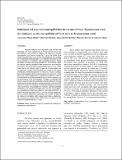| dc.contributor.author | Zeledón, Rodrigo | |
| dc.contributor.author | Mena-Marín, Ana Laura | |
| dc.contributor.author | Morales, Juan Alberto | |
| dc.contributor.author | Pereira, Mauricio | |
| dc.contributor.author | Urbina-Villalobos, Andrea | |
| dc.date.accessioned | 2020-09-02T00:25:21Z | |
| dc.date.available | 2020-09-02T00:25:21Z | |
| dc.date.issued | 2012-10-07 | |
| dc.identifier.uri | http://hdl.handle.net/11056/18043 | |
| dc.description.abstract | Some authors have reported that female mice are more resistant to Trypanosoma cruzi infections than male mice. In order to test this hypothesis we did a comparative study using four isolates of T. cruzi from Costa Rica in a total of 160 mice, and observed several parameters such as: parasitemia levels, percent mortality and histopathology. All isolates were identified as genotype TcI. Male mice were more susceptible to infection (P<0.001). Parasitemias reached levels up to five times higher in males and shorter survival periods were observed in males than in females. The Oswaldo isolate showed the highest parasitemias and mortality rates. The heart tissue was the most affected in both males and females. In two isolates the number of parasites in the heart was significantly higher in males than in females. In separate experiments, the human GA isolate was selected in order to observe its effect in castrated male and female mice. Non-castrated females were the most resistant, with lower parasitemias than castrated females, and non-castrated males were the most susceptible with higher parasitemias (P<0.001) and lower survival periods than castrated males (P<0.01). There was no significant difference in the number of parasites in tissues between normal and castrated mice. The final conclusion is that there is a marked sex influence in the susceptibility of mice to T. cruzi experimental infections. | es_ES |
| dc.description.abstract | Algunos estudios han reportado que los ratones hembras son más resistentes al Trypanosoma cruzi que los machos. Para probar lo anterior, se realizo un estudio comparativo con cuatro cepas de T. cruzi de Costa Rica midiendo parámetros como niveles de parasitemia, porcentajes de mortalidad e histopatología, en un total de 240 ratones (160 para parasitemia y mortalidad y 80 para histopatología). Todas las cepas correspondieron al genotipo TcI. En todos los casos los ratones machos resultaron más susceptibles a la infección (P<0,001). Se observaron parasitemias hasta cinco veces más altas en los machos que, en general, mueren antes que las hembras. La cepa Oswaldo fue la que presentó una mayor mortalidad y niveles de parasitemia más altos. El tejido cardiaco fue el más afectado tanto en los ratones machos como en las hembras, con las cepas Bolita y Capitán el número de nidos en el miocardio fue significativamente mayor en los machos que en las hembras. Una vez concluido el análisis comparativo se eligió la cepa humana GA, para determinar su efecto en ratones machos y hembras castrados, al lado de ratones normales (150 ratones en total). Las hembras normales se mostraron como las más resistentes, con parasitemias menores que las castradas (P<0,001), y los machos normales como los más susceptibles, con parasitemias significativamente más altas (P<0,001) y supervivencias menores (P<0.01), que los ratones castrados. No se observó diferencia significativa en cuanto al número de nidos en los tejidos entre ratones normales y castrados. Se concluye que el sexo tiene influencia en la resistencia a la infección experimental por T. cruzi. | es_ES |
| dc.description.sponsorship | Universidad Nacional, Costa Rica | es_ES |
| dc.language.iso | spa | es_ES |
| dc.publisher | Boletin de Malariologia y Salud Ambiental | es_ES |
| dc.rights | Acceso abierto | es_ES |
| dc.source | BOLETÍN DE MALARIOLOGÍA Y SALUD AMBIENTAL Vol. LII, Nº 2, Agosto-Diciembre, 2012 | es_ES |
| dc.subject | TRYPANOSOMA CRUZI | es_ES |
| dc.subject | CASTRACION | es_ES |
| dc.subject | PARASITOS | es_ES |
| dc.subject | ESTROGENOS | es_ES |
| dc.subject | HORMONAS | es_ES |
| dc.subject | RATA | es_ES |
| dc.subject | CASTRATION | es_ES |
| dc.subject | ESTROGEN | es_ES |
| dc.title | Sex influence on the susceptibility of Swiss mice to Trypanosoma cruzi [Influencia del sexo en la susceptibilidad de ratones Swiss a Trypanosoma cruzi] | es_ES |
| dc.type | http://purl.org/coar/resource_type/c_6501 | es_ES |
| dc.description.procedence | Escuela de Medicina Veterinaria | es_ES |

